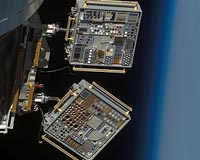 |
Adelaide, Australia (UPI) Oct 8, 2009 An Australian-led team of international scientists says it's found the bacterium Cupriavidus metallidurans catalyses toxic gold compounds into metallic form. Researchers previously reported the presence of bacteria on gold surfaces, but it was never determined what purpose they served. In the new study, led by University of Adelaide research fellow Frank Reith, scientists have found there might be a biological reason for the presence of bacteria on gold grain surfaces. "A number of years ago we discovered that the metal-resistant bacterium Cupriavidus metallidurans occurred on gold grains from two sites in Australia," Reith said. "The sites are (2,175 miles) apart in southern New South Wales and northern Queensland. So when we found the same organism on grains from both sites it made us wonder why these organisms live in this particular environment. "The results of this study point to their involvement in the active detoxification of (gold) complexes leading to formation of gold biominerals," he said. Experiments showed C. metallidurans rapidly accumulates toxic gold complexes, promoting gold toxicity. That, researchers said, pushes the bacterium to induce oxidative stress and metal resistance clusters in order to defend its cellular integrity. That, in turn, leads to active biochemically-mediated reduction of gold complexes into nano-particulate, metallic gold, which might contribute to the growth of gold nuggets. The study appears in the Proceedings of the National Academy of Sciences. Share This Article With Planet Earth
Related Links Space Technology News - Applications and Research
 ORMatE Returns To NRL After Nearly Two Years In Earth Orbit
ORMatE Returns To NRL After Nearly Two Years In Earth OrbitWashington DC (SPX) Oct 01, 2009 Completing an 18-month mission orbiting the Earth more than 6,000 times on-orbit the International Space Station (ISS), the Optical Reflector Material Experiment (ORMatE-1) returns to Washington, D.C., to NRL's Electronics Science and Technology Division to begin experiment testing and analysis. Retrieved September 2009 by the crew of NASA's Space Shuttle Endeavour, ORMatE-1 is a passive ... read more |
|
| The content herein, unless otherwise known to be public domain, are Copyright 1995-2009 - SpaceDaily. AFP and UPI Wire Stories are copyright Agence France-Presse and United Press International. ESA Portal Reports are copyright European Space Agency. All NASA sourced material is public domain. Additional copyrights may apply in whole or part to other bona fide parties. Advertising does not imply endorsement,agreement or approval of any opinions, statements or information provided by SpaceDaily on any Web page published or hosted by SpaceDaily. Privacy Statement |